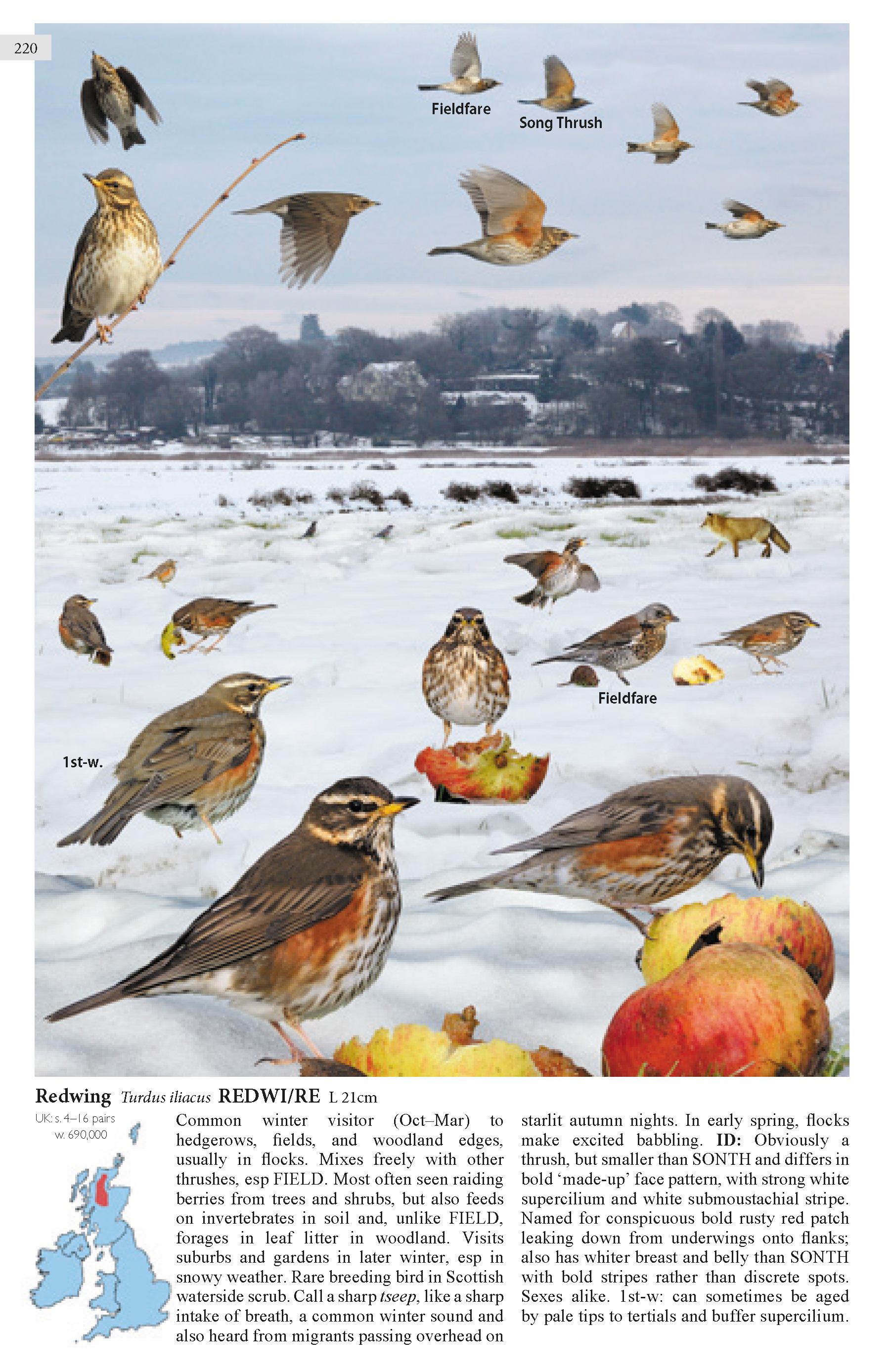 Every now and then comes a significant development in field guides. Arguably landmark guides include the Peterson Field Guide with its indications of visual field marks, Lars Jonsson's Birds of Europe with beautiful and aesthetic illustrations and most people's current favourite for use today, the Collins Field Guide. Photographic guides have never quite achieved this level of acceptability – whilst several have been produced most birders would agree that they have never been able to capture sufficient variety and information to match the best of the more "traditional" guides. Richard Crossley's Crossley ID Guide: Britain & Ireland attempts to rectify this and meld it with the best aspects of other field guides, using photographs and a presentation approach that focus on teaching the reader/viewer to observe and develop as a better birder.
Every now and then comes a significant development in field guides. Arguably landmark guides include the Peterson Field Guide with its indications of visual field marks, Lars Jonsson's Birds of Europe with beautiful and aesthetic illustrations and most people's current favourite for use today, the Collins Field Guide. Photographic guides have never quite achieved this level of acceptability – whilst several have been produced most birders would agree that they have never been able to capture sufficient variety and information to match the best of the more "traditional" guides. Richard Crossley's Crossley ID Guide: Britain & Ireland attempts to rectify this and meld it with the best aspects of other field guides, using photographs and a presentation approach that focus on teaching the reader/viewer to observe and develop as a better birder.
In 2011, Crossley published his first photographic guide: a field guide to the birds of eastern North America. Whilst opinions on it were divided, it was universally agreed that this really was something different. Now the long-awaited British and Irish equivalent is out. What? A British and Irish field guide by an American author? Well, the other way round actually; Crossley is from Yorkshire – which means that one of the authors of this review may show a little bias...
 Anyway, for those who haven't come across either guide yet, you may be wondering what's so different. Crossley has spent years taking a LOT of photos – 5,000 are included in the book apparently. What is different from other photographic guides though is that the photos are then digitally cut out of their original settings and are placed, alongside others of the same species, in a single shot of a landscape. The birds are sized appropriately to appear at a variety of scales from near to far, to give a "realistic" impression of what birds look like in the field.
Anyway, for those who haven't come across either guide yet, you may be wondering what's so different. Crossley has spent years taking a LOT of photos – 5,000 are included in the book apparently. What is different from other photographic guides though is that the photos are then digitally cut out of their original settings and are placed, alongside others of the same species, in a single shot of a landscape. The birds are sized appropriately to appear at a variety of scales from near to far, to give a "realistic" impression of what birds look like in the field.
Now, admittedly, the resulting images are verging on the "hyper-real" at times. There can be a bewildering number of individuals sometimes in the same plate, which is often a little freaky for a species like Sparrowhawk that one tends to encounter individually. Broadly though, once one gets over this, the stated aims of the approach are achieved, which is to give the birdwatcher a feel for the real in-field impression of the species. I felt it was particularly good at giving help with the jizz of flying skuas and terns, plus Merlin which can be a tricky bird for beginners to get a feel for. What doesn't necessarily come across so well in two dimensions is the relative size of different birds; I would like to have seen confusion species introduced on many plates, e.g. Peregrine with Merlin, Sparrowhawk with Buzzard and Kestrel, but it would be difficult to know whether the different images were meant to be at the same distance and could be compared for size, or whether one was further away.
 The background landscapes are generally relevant to the species and, especially for the well-travelled birder, are one of the delights of the book as you can play "name that place". Again, Crossley has clearly spent an enormous amount of time gathering these images. Well known sites such as Fair Isle, Cley, Slimbridge, Flamborough and many more all make an appearance. I think Radipole sneakily appears at least twice from slightly different angles! But even ignoring the birds, the book is a fabulous collection of photos of the British (and Irish?) countryside at the start of the 21st century.
The background landscapes are generally relevant to the species and, especially for the well-travelled birder, are one of the delights of the book as you can play "name that place". Again, Crossley has clearly spent an enormous amount of time gathering these images. Well known sites such as Fair Isle, Cley, Slimbridge, Flamborough and many more all make an appearance. I think Radipole sneakily appears at least twice from slightly different angles! But even ignoring the birds, the book is a fabulous collection of photos of the British (and Irish?) countryside at the start of the 21st century.
The photos are clearly the main part of the book and the accompanying text by Dominic Couzens is relatively short, but it's concise, useful and accurate. Each of the regular species also has a small map depicting broad patterns of distribution, although those species presumably considered too rare for a map include some surprise ones: Corn Crake, Quail, Yellow-legged Gull, Woodlark and Hawfinch for example. Crossley has chosen to follow the BOU/BBRC species names and categorisations for species status (excluding official rarities for example), and the BTO defined short codes for species names. It is good to see the adoption of recommendations from higher-level "authorities" in this way - too often field guide authors like to be "cutting-edge" and introduce different species names and taxonomies that may not have been so well thought through. The taxonomic treatment of Redpoll (lumping Common/Mealy with Lesser as "Common Redpoll") is however at odds with the current BOU treatment. The five character short names are used in the helpful visual index to all species at the front of the book, although here I wish the author (and/or type-setters) had made the effort to use the full species names – this section is likely to be used primarily by beginners and the extra step of working out exactly which species from the short name is not ideal in a "quick" reference. Where Crossley has deviated from conventional taxonomic wisdom though is in the species ordering – moving away from genetic relationships into grouping species by habitat preference and "type", e.g. Swimming Waterbirds, Flying Waterbirds and Walking Waterbirds. This certainly makes more sense for identification purposes, and taxonomic-based orders aren't as consistent as one might think anyway!
 Inevitably, given the scale of the task Crossley has set himself, it's easy to pick out gripes if you want to. Some of the pictures work better than others, and a minority of the images do have an unconvincing size or lighting within the background. For example, there's a chap who looks understandably terrified at being mobbed by a Great Skua with what must be a 12 foot wingspan! Other things that jarred slightly were having photos of breeding adults of Aquatic and Barred Warbler, which are not relevant in a British/Irish context, and the fact that a rocky beach setting has been used for Yellow-legged Gull (which as everyone knows, almost exclusively live in pig fields.) It's clear that Crossley has leant heavily on his earlier American guide, but saying that Great Black-backed Gull may feed on birds such as "AMCO", i.e. American Coot, should have been spotted before publication.
Inevitably, given the scale of the task Crossley has set himself, it's easy to pick out gripes if you want to. Some of the pictures work better than others, and a minority of the images do have an unconvincing size or lighting within the background. For example, there's a chap who looks understandably terrified at being mobbed by a Great Skua with what must be a 12 foot wingspan! Other things that jarred slightly were having photos of breeding adults of Aquatic and Barred Warbler, which are not relevant in a British/Irish context, and the fact that a rocky beach setting has been used for Yellow-legged Gull (which as everyone knows, almost exclusively live in pig fields.) It's clear that Crossley has leant heavily on his earlier American guide, but saying that Great Black-backed Gull may feed on birds such as "AMCO", i.e. American Coot, should have been spotted before publication.
There is no doubt that this book is aimed at the beginner or less experienced birdwatcher, and this is welcome - too often I have seen birders bemused by the number of species and great detail given to rarities in excellent new field guides, and hence losing the ability to step back and think rationally about the identification process from the start. In this aspect Crossley's introductory section is excellent in talking through the process of bird identification – the best I have seen in any recent field guide and a recommended refresher for experienced birders too. In fact I doubt that there is an "expert" birder who wouldn't gain something from working through this guide and the birding habits it encourages. It's also really good value, given the astonishing amount of material in the book, and we personally recommend it. However, if you're still not sure, there's an even better option. If you join the BTO now then you can get a copy for free! What's not to like?!
Andy Musgrove & Mike Prince
You can help support BUBO Listing by buying The Crossley ID Guide: Britain & Ireland through the BUBO Store.
